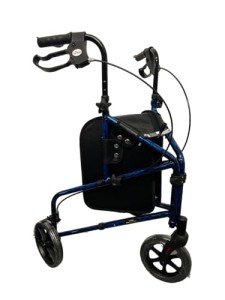adjustable-walker4539
adjustable-walker4539
10 Rollator With Storage Tricks All Experts Recommend
Rollator with Storage: A Comprehensive Guide for Independent Mobility
Rollators are mobility aids developed to help individuals with walking problems while promoting self-reliance and safety. Unlike conventional walkers, rollators come geared up with wheels for simple and easy navigation, making them a necessary tool for lots of elderly and disabled people. Among the key features that improve the functionality of rollators is storage. This short article explores rollators with integrated storage alternatives, highlighting their benefits, types, and important considerations when choosing the right model.

Comprehending Rollators
What is a Rollator?
A rollator is a wheeled walker that supplies support for people who might battle with balance or endurance. Usually, rollators are developed with the following functions:
- Wheels: Rollators are equipped with either 2 or 4 wheels, enabling for smooth maneuverability.
- Hand Brakes: Most have hand brakes for included safety, enabling users to manage their speed.
- Seat: Many designs include a built-in seat, supplying a resting point when required.
- Storage: Rollators often include baskets or bags for carrying individual items like water bottles, groceries, or medical products.
Benefits of Using a Rollator with Storage
The inclusion of storage choices in rollators brings a number of benefits:
- Convenience: Users can easily transport individual possessions, decreasing the requirement for extra help.
- Independence: Having access to important products while being mobile empowers individuals to keep their independence in different environments, such as supermarket, parks, or homes.
- Safety: By safely keeping products, users can more with confidence navigate their environments without the risk of dropping valuable items.
- Comfort: Having a seat for resting permits users to take breaks when required, even more enhancing mobility.
Kinds of Rollators with Storage
Numerous kinds of rollators come geared up with storage options:
| Rollator Type | Description | Ideal for |
|---|---|---|
| Standard Rollator | Normally includes four wheels and a sturdy frame. Storage options, like an integrated bag or basket, are frequently consisted of. | General use, outdoors |
| Compact Rollator | A smaller variation that folds easily for transport. While these designs often have limited storage, numerous still consist of very little functionality. | Travelers and tight areas |
| Durable Rollator | Designed for bigger people, these rollators often have much better storage capability. | Bigger users, stability requires |
| Rollator with Seat | Features a built-in seat for resting. Storage choices differ, often consisting of baskets or shopping bags. | Those requiring regular breaks |
| Walker-Carrier Combo | Function as both a rollator and a lightweight cart, ideal for shopping journeys. | Grocery shopping, outdoor use |
Picking the Right Rollator with Storage
When choosing a rollator with storage, numerous factors should be considered to make sure that it satisfies private requirements.
Secret Features to Assess
- Weight Capacity: Always check the weight limitation of the rollator to ensure safety and use.
- Size and Foldability: Consider how the rollator suits your home and whether it can be quickly stored or transported.
- Storage Capacity: Assess the size and availability of storage compartments. Look for options that enable safe storage without overwhelming the user with complexity.
- Adjustable Handles: Ensure that the deals with can be gotten used to the proper height to enhance comfort and ergonomics.
- Braking System: A reputable braking system is vital. Guarantee the brakes are easy to engage and disengage.
- Wheel Size and Type: Larger wheels can browse rougher surface, while smaller ones might be better for flat surfaces.
Additional Considerations
- Accessories: Many rollators have optional devices, such as cup holders or seat cushions, to improve user experience.
- Service warranty and Support: Investigate whether the manufacturer offers a guarantee for problems or damages.
- User Reviews: Online customer evaluations can use valuable insights into performance and fulfillment.
Upkeep and Care of Rollators
To guarantee longevity and ideal performance, regular upkeep is essential. Users ought to consider the following practices:
- Regular Cleaning: Wipe down the frame and elements to prevent rust and preserve hygiene.
- Examine Brakes: Ensure that the brakes are operating appropriately and adjust them as needed.
- Examine Wheels: Regularly check for any particles captured in the wheels or signs of wear and tear.
- Tighten Hardware: Periodically check and tighten up screws or bolts to maintain safety.
Regularly Asked Questions (FAQs)
1. How do I pick the ideal size rollator for me?
Choosing the right size involves examining your height and weight, together with checking deal with height changes to make sure that it appropriates for your stature.
2. Can I use a rollator on irregular surface?
Yes, some rollators are created with larger wheels and shock-absorbing systems that make them more ideal for irregular surface. It’s necessary to examine the specifications.
3. Is it simple to fold a rollator for transport?
Many modern rollators are created to be easily foldable. Search for guidelines in the user handbook that accompany your picked design.
4. How much weight can a common rollator assistance?
A lot of basic rollators support in between 250 to 350 pounds; nevertheless, sturdy models can support higher weights.

5. Can I add accessories to my rollator?
Yes, many rollators included the choice of including accessories like cup holders, trays, and bags to boost functionality.
In summary, a rollator with storage is a valuable mobility aid that empowers individuals while supplying them with the convenience of transferring necessary items. By understanding the different types, crucial functions, and upkeep requirements, users can confidently pick the right rollator that fits their lifestyle, promoting independence and convenience in day-to-day activities. As mobility aids continue to evolve, they end up being increasingly vital for improving the lifestyle for elderly and disabled people.


